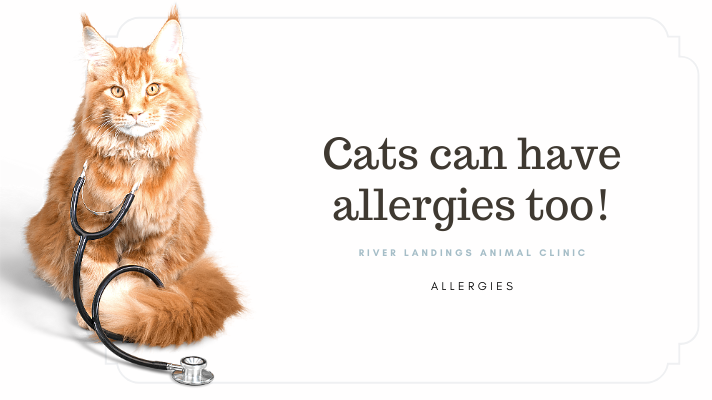Asthma is a disease of the lower airways of the lungs that affects between 1 and 5% of cats.
Although there is some debate about the definition, most clinicians and researchers agree that feline asthma is caused by an allergic reaction to inhaled allergens— particles that stimulate a cat’s immune system.
When a susceptible cat first inhales an allergen, their system creates specific antibodies to target that antigen. When the cat is exposed to that antigen again, these antibodies recognize the allergen and start a cascade of events that bring many different types of immune cells to the airways. These immune cells then trigger the production of substances that promote inflammation, a condition that results in irritation, swelling, and reactive constriction of the airways. As a result, the diameter of the airways may decrease and mucus may accumulate within the passages. All these processes limit the ability of air to move through the airways and cause the cat to experience difficulty breathing.
The average age of cats diagnosed with asthma is between 4 and 5 years. It doesn’t appear that one sex is more susceptible to asthma, and although some studies suggest that Siamese cats may be predisposed to asthma, this has not been definitively proven.
Clinical Signs of Feline Asthma
Cats suffering from asthma may show signs of:
difficulty breathing
wheezing
rapid breathing
coughing or hacking
open-mouthed breathing
vomiting
These signs can vary in intensity, ranging from acute respiratory crises to chronic, low-grade coughing, elevated respiratory rate, or increased respiratory effort. These signs may happen spontaneously or they may be elicited by pressing lightly on the cat’s throat area. During an asthma attack, many cats hunch their body close to the ground and extend their necks forward in a characteristic posture
Diagnosis of Feline Asthma
There is no single, specific test that can definitively diagnose feline asthma. Instead, veterinarians rely on information gathering and testing to arrive at a diagnosis. If a veterinarian suspects your cat may have asthma, he or she will take into account the cat’s health history as well as the results of imaging studies, microscopic evaluation of the cells in the cat’s airway secretions (cytology), and in some cases, blood and allergy testing.
When it comes to diagnosing feline asthma, a picture is worth a thousand words, so veterinarians employ radiographs (X-rays), computed tomography (CT), and bronchoscopy to see inside a cat’s lungs and evaluate their condition. In cats with asthma, radiographs often – but not always – reveal a characteristic bright branching pattern along the airways that is created by the accumulation of inflammatory cells. Air trapped in the constricted airways may also cause the lungs to become overinflated and appear larger than normal in a radiograph. CT, which uses X-rays to generate three-dimensional reconstructions of the body, may also be useful in diagnosing asthma and distinguishing this condition from other causes of airway disease in cats, but this application of CT is still somewhat experimental.
Bronchoscopy is a technique in which a flexible camera (a bronchoscope) is passed through the mouth and down into the airways of the lungs. This technique, which requires either heavy sedation or general anesthesia, can be used to visualize the inside of the airways and to collect samples of cells that line the airways. Cats with asthma often have distinctive changes in the appearance of the lining of their airways, although some of these changes may also be seen with other respiratory diseases of cats. Analysis of cells from the airways of cats with asthma may reveal the presence of high numbers of inflammatory cells, although these cells may also be found in cats suffering from other respiratory diseases.
When diagnosing feline asthma, it’s crucial to rule out other conditions that can cause similar signs and give similar test results. Chronic bronchitis, infestation with lungworms, migration of other parasites into the lungs, as well as other infectious diseases that result in pneumonia can all result in signs and test results similar to those found in a case of feline asthma. Drugs used to treat these other conditions may not be appropriate for a cat with asthma, and may do more harm than good.
Treatment of Feline Asthma
To treat feline asthma, veterinarians will usually prescribe corticosteroids to reduce inflammation in the lungs, with or without bronchodilators to dilate the airways. Both of these types of drugs come in oral, inhaled, and injectable forms. Although corticosteroids may be used alone, bronchodilators are usually not used on their own as they don’t treat the airway inflammation that brings on asthma.
Other drugs and treatments for feline asthma have not yet been conclusively proven to work. Experimental therapies, including desensitization to specific allergens (like allergy shots in people), the use of omega-3 fatty acids, and drugs intended to disrupt the metabolic pathways that lead to inflammation show some promise for treating feline asthma, but further research is necessary to refine them and prove their safety and effectiveness. Other approaches are sometimes recommended because they are beneficial in human asthma patients, including purifying indoor air and avoiding allergens, but they have not been rigorously tested or proven to work in feline asthma patients.
Prognosis of Feline Asthma
Feline asthma is often a progressive condition that fails to improve significantly over time, and affected cats may experience occasional asthmatic flare-ups that vary in intensity from mild to life threatening. Although cats can never be truly “cured” of asthma, by carefully monitoring their respiratory effort, keeping an eye out for coughing, and intervening with medication when they need help, owners can help their asthmatic cats live happily for years.
Hear From Us Again
Don't forget to subscribe to our email newsletter for more recipes, articles, and clinic updates delivered straight to your e-mail inbox.
Related Categories:




